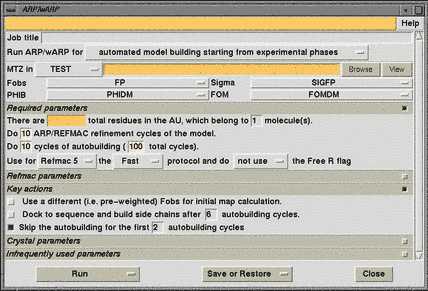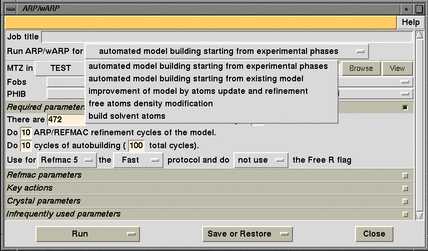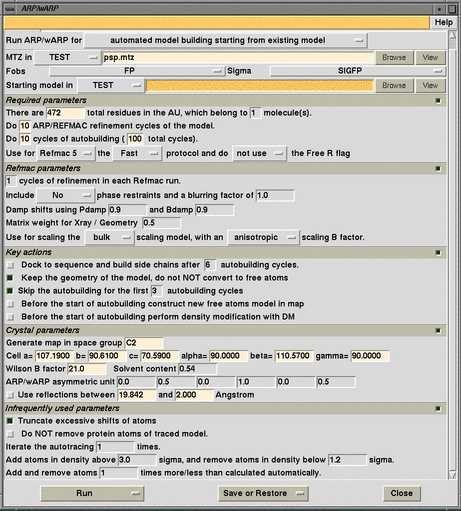Newsletter contents... 
ARP/wARP goes CCP4i
Anastassis Perrakis, Liz Potterton and Victor Lamzin
The ARP/wARP package, from version 5.0 onwards, has diverted from the
classical way of executing CCP4 programs. Instead of relying on the user
to edit command files and run them, arp_warp_setup.sh
was extracting the necessary information from the user input and setting
up a 'parameter' file (warp.par) which was further used by the scripts
within the package. Such an approach was necessary, because of the complexity
of the arp_warp.sh file.
Now ARP/wARP is back to the mainstream. The ARP/wARP CCP4i interface
was designed based on the principles and libraries developed by Liz Potterton
and the CCP4 staff. The ARP/wARP is based on CCP4i and looks like CCP4i,
however it is not exactly CCP4i. The underlying architecture of the 'warp.par'
file and the 'arp_warp.sh' script is maintained for the GUIphobic folks
out there. 'arp_warp_setup.sh' will go on working alright, but the CCP4i
'layer' is there to make running ARP/wARP even easier.
The ARP/wARP CCP4i interface exemplifies how a wide variety of CCP4
programs can be used together with other 'user-modules' (in this case the
autobuilding programs) and command scripts under a common
user-appearance, the CCP4i interface look-and-feel, in order to achieve
a certain crystallographic goal, in our case combination of model
building and refinement.
The main features of the ARP/wARP CCP4i interface include:
-
Single button tracing: All you have to do is to browse for the name of
the mtz file which has the amplitudes and phases, press 'Run' and ARP/wARP
will deliver a pdb file with the model! There is some controversy regarding
the number of residues input: ARP/wARP can suggest it to you, but given
that you should at least know how big your protein is, this input will
be obligatory for now! A new feature is that you can choose if you want
to dock the autotraced parts to the known amino-acid sequence towards the
last cycles of autobuilding. This way, you do not have to run the side
chain docking as a standalone script and at the same time there is no
effort spend on docking the initial, incomplete, models to the sequence.
|

|
-
There is simple choice between diverse protocols: Autobuilding from experimental
phases, autobuilding starting from a pre-existing model, model refinement
by atoms update, just free atoms refinement to improve a map or solvent
building are the choices. Lots of things are made easy this way, especially
'start' files do not have any more cryptic names, but can be chosen from
any directory.
|

|
-
Although everything has defaults, you can customise almost all the parameters.
It is a central point in the philosophy of the interface that nearly user-free
operation must be possible, while retaining all the functionality that
is desired by the expert user. The user can set preferred parameters for
ARP specific things (like the sigma values for adding and deleting atoms),
most of the available 'REFMAC' parameters, or modify the way the ARP/wARP
protocol works (i.e. include solvent flattening before start, and others).
Special care has been given to the treatment of the autobuilding when starting
from an existing model. Some of the choices available specifically for
this mode are extremely usefull when starting from 'nasty' molecular replacement
solutions (more about that will be published in the CCP4 study weekend
proceedings).
|

|
-
Apart from the usual 'screen output' of the arp_warp.sh script, which is
now the 'Log file' for the CCP4i job, all other extensive log files from
refinement, custom graph files, output PDB files and map files can be found
under 'Output files' from the main CCP4i window. The graph files are now
compatible with 'loggraph' of CCP4i and a few defaults presentations are
chosen which are handy for quick inspection of the job.
|

|
The ARP/wARP CCP4i interface will be available soon through the ARP/wARP
release 5.2 from http://www.arp-warp.org. It will be compatible with
CCP4 4.1 and will be included in the main CCP4 distribution from version
4.2 onwards.

Newsletter contents... 



